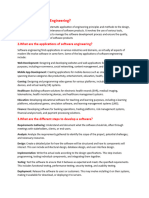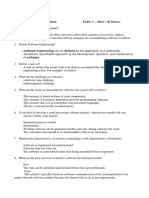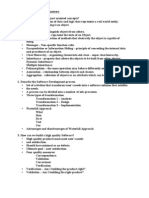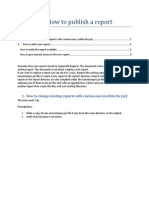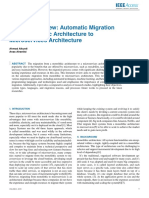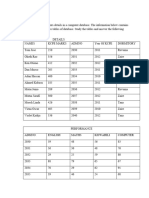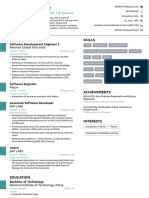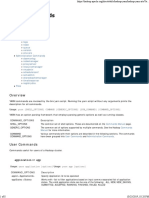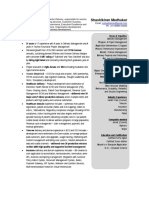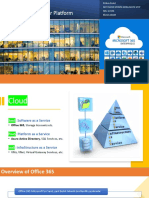Okay, let's dive into Software Engineering interview questions with answers and explanations.
These questions often cover the software development lifecycle, methodologies, best practices,
and design principles.
1. What is the Software Development Life Cycle (SDLC)? What are its phases?
● Answer: The Software Development Life Cycle (SDLC) is a conceptual framework that
describes the stages involved in a software development project, from its initial
conception to its retirement.
● Phases (common representation):
1. Planning/Requirement Gathering: Defining the project scope, objectives, and
gathering requirements from stakeholders.
2. Design: Creating the architecture, data structures, and user interfaces of the
software.
3. Implementation/Coding: Writing the actual code based on the design.
4. Testing: Verifying and validating the software to ensure it meets the requirements
and is free of defects.
5. Deployment: Making the software available for use in its intended environment.
6. Maintenance: Supporting, updating, and fixing issues in the software after
deployment.
● Explanation: Understanding the SDLC provides a structured approach to software
development, ensuring all necessary steps are considered. Different methodologies (like
Agile or Waterfall) implement these phases in varying ways.
2. What are different Software Development Methodologies? Can you compare Agile and
Waterfall?
● Answer: Software development methodologies are frameworks used to structure, plan,
and control the process of developing information systems.
● Examples: Waterfall, Agile (Scrum, Kanban), Lean, Spiral.
● Agile vs. Waterfall: | Feature | Agile | Waterfall | | :--------------- |
:---------------------------------------- | :----------------------------------------------- | | Approach |
Iterative and incremental | Linear and sequential | | Requirements | Evolving, can change
during development | Fixed and well-defined upfront | | Testing | Integrated throughout the
process | Typically done after implementation | | Customer Input | High involvement
throughout | Primarily at the beginning and end | | Flexibility | Highly flexible to changes |
Less flexible to changes | | Best Suited For | Projects with unclear or changing needs |
Projects with well-defined and stable requirements |
● Explanation: The choice of methodology depends on the project's nature, team size, and
stakeholder needs. Agile is often preferred for its adaptability, while Waterfall might be
suitable for projects with very clear and unchanging requirements.
3. What are the principles of Object-Oriented Programming (OOP)?
● Answer: The four main principles of OOP are:
1. Encapsulation: Bundling data (attributes) and the methods that operate on the
data into a single unit (a class). It helps in hiding the internal implementation details.
2. Abstraction: Showing only the necessary information to the user and hiding the
complex implementation details. Often achieved through abstract classes and
interfaces.
3. Inheritance: A mechanism where a new class (subclass/derived class) inherits
properties and behaviors from an existing class (superclass/base class). This
promotes code reusability.
4. Polymorphism: The ability of an object to take on many forms. This can be
� achieved through method overloading (same method name, different parameters)
and method overriding (subclass providing a specific implementation of a method
inherited from the superclass).
● Explanation: These principles help in creating modular, maintainable, and reusable code.
4. What are Design Patterns? Can you name a few?
● Answer: Design patterns are reusable solutions to common problems in software design.
They are not specific pieces of code but rather blueprints or templates for how to solve
certain kinds of problems.
● Examples:
○ Creational: Singleton, Factory, Abstract Factory, Builder.
○ Structural: Adapter, Decorator, Facade, Proxy.
○ Behavioral: Observer, Strategy, Template Method, Command.
● Explanation: Using design patterns can lead to more robust, flexible, and understandable
software by leveraging proven solutions.
5. What is the difference between coupling and cohesion? Why are low coupling and high
cohesion desirable?
● Answer:
○ Coupling: The degree of interdependence between software modules. Low
coupling means modules are relatively independent of each other.
○ Cohesion: The degree to which the elements within a module belong together.
High cohesion means the elements within a module are strongly related and
focused on a single purpose.
● Why desirable:
○ Low Coupling: Makes the system easier to understand, maintain, and modify
because changes in one module are less likely to affect others.
○ High Cohesion: Leads to more focused and understandable modules that are
easier to reuse and test.
● Explanation: Aiming for low coupling and high cohesion is a fundamental principle of
good software design, leading to more maintainable and robust systems.
6. What are unit testing, integration testing, and system testing?
● Answer:
○ Unit Testing: Testing individual units or components of the software in isolation to
ensure they function correctly.
○ Integration Testing: Testing the interactions between different units or modules to
ensure they work together as expected.
○ System Testing: Testing the entire integrated system to verify that it meets the
specified requirements.
● Explanation: These different levels of testing are crucial for ensuring the quality of the
software at various stages of development.
7. What is version control? Why is it important? Can you name a popular version control
system?
● Answer: Version control is a system that records changes to a file or set of files over time
so that you can recall specific versions later.
● Importance:
○ Allows multiple developers to work collaboratively without overwriting each other's
changes.
○ Provides a history of changes, making it easy to revert to previous versions.
○ Facilitates branching and merging for feature development and bug fixes.
� ● Popular System: Git. Others include SVN (Subversion).
● Explanation: Version control is essential for modern software development, enabling
collaboration, tracking changes, and managing different versions of the codebase
effectively.
8. What are SOLID principles?
● Answer: SOLID is an acronym representing five fundamental principles of object-oriented
design that aim to make software designs more understandable, flexible, and
maintainable:
○ Single Responsibility Principle: A class should have only one reason to change.
○ Open/Closed Principle: Software entities (classes, modules, functions, etc.) should
be open for extension but closed for modification.
○ Liskov Substitution Principle: Subtypes must be substitutable for their base types.
○ Interface Segregation Principle: Clients should not be forced to depend on
interfaces they do not use.
○ Dependency Inversion Principle: Depend upon abstractions, not concretions.
● Explanation: Applying these principles helps in creating loosely coupled and highly
cohesive designs.
9. What is refactoring? Why is it important?
● Answer: Refactoring is the process of restructuring existing computer code—changing
the factoring—without changing its external behavior. It is done to improve the
nonfunctional attributes of the software, such as readability, maintainability, and
performance.
● Importance:
○ Improves the design of the software.
○ Makes the code easier to understand.
○ Helps find bugs.
○ Makes programming faster in the long run.
● Explanation: Regular refactoring is a good practice to keep the codebase clean and
maintainable as it evolves.
10. What are microservices? How do they differ from a monolithic architecture?
● Answer:
○ Microservices: An architectural style that structures an application as a collection
of small, independent services, built around business capabilities. Each service
runs in its own process and communicates with other services, often over a network
using lightweight mechanisms (e.g., HTTP API).
○ Monolithic Architecture: A traditional model where all the components of an
application are tightly coupled and deployed as a single unit.
● Key Differences: | Feature | Microservices | Monolithic | | :--------------- |
:------------------------------------------ | :--------------------------------------------- | | Architecture |
Collection of small, independent services | Single, large codebase | | Deployment |
Independent deployment of each service | Single deployment of the entire application | |
Technology Stack | Different services can use different stacks | Usually a consistent
technology stack | | Scalability | Individual services can be scaled | Entire application
needs to be scaled | | Fault Isolation | Failure in one service doesn't affect others | Failure
in one part can affect the whole system |
● Explanation: Microservices offer benefits like scalability, flexibility in technology choices,
and better fault isolation but also introduce complexity in terms of distributed systems
management.
�These are some common and important questions in Software Engineering interviews.
Depending on the role, you might also get questions about specific technologies, databases,
cloud platforms, etc.
Do you have any specific areas within Software Engineering you'd like to focus on?









